3 killed in Northern California as powerful storm’s wicked winds snap trees, cut power
The second of two powerful atmospheric storms walloped Northern California, killing three people and leaving a path of fallen trees, snapped power lines and debris on roadways in the capital region and elsewhere before moving Monday over the south state. From Ventura to San Diego, torrential rain was expected to create flooding and mudslide conditions.
The Sacramento region was battered Sunday with gusts of nearly 70 mph for more than eight hours that knocked down branches, power poles and fences. Meanwhile, rainfall averages were just about normal or a little above normal, according to Nathan Rick, a meteorologist with the National Weather Service in Sacramento.
Still, the extreme gusts made travel difficult and led to the deaths of three men from fallen trees, authorities confirmed Monday afternoon.
The first occurred about 2 p.m. Sunday in Carmichael, when a tree struck a 41-year-old man on Gibbons Drive, according to the Sacramento County Coroner’s Office. Authorities said Chad Ensey, a resident of Carmichael, died at a hospital after the tree fell on him in his backyard.
The second came close to 7 p.m. Sunday in Yuba City, where an 82-year-old trying to keep a redwood from landing on his home was crushed by the tree when it fell, according to police in the Sutter County city.
Officers found the man, identified as David Gomes, underneath the tree when they arrived to Tres Picos Drive, police said. Investigators said he was possibly using a ladder to clear the tree away from his home when it came down.
“This was an unfortunate accident and our condolences are with the male’s family and friends,” police said.
The third happened in Boulder Creek, Santa Cruz County, when a tree crashed through a home, killing a 45-year-old resident, according to Brian Ferguson, a spokesman for the Governor’s Office of Emergency Service, which deployed 8,300 personnel across the state in preparation for the storm.
In all three cases, officials said, the storm’s terrifying and relentless winds were blamed for the fatal ordeals.
Rick noted high winds are not normal for Northern California, but not abnormal when accounting for the weather’s strength that unleashed Sunday.
“Certainly, an impactful one,” Rick said of the storm.
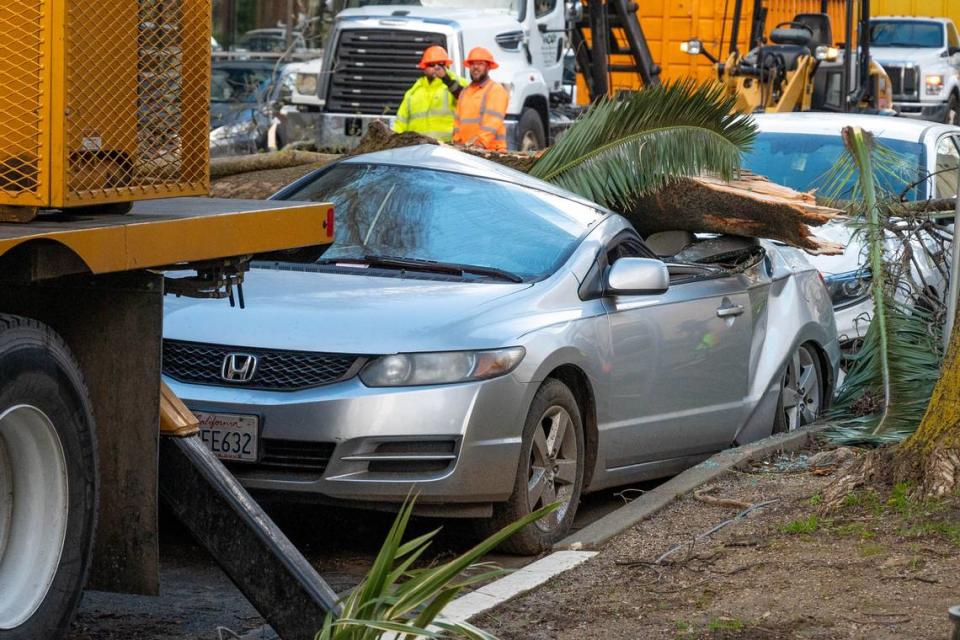
Widespread outages in SMUD, PG&E territory
As cleanup crews and homeowners fanned out across Sacramento to wrestle debris, electricity was slowly being restored across the county.
“Damage is widespread across SMUD’s service area,” the utility said in an update just before noon. “There are currently more than 40 poles and 360 wires down, and over 80 job sites that require complex tree work before repairs can be made.”
By 4 p.m., about 21,000 customers of the Sacramento Municipal Utility District remained without power. At the height of the storm, about 200,000 homes and businesses were plunged into the dark.
SMUD officials said more than 80 crews worked through the night and would continue to work “on a 24/7 basis to assess damage, make repairs and restore power to all customers.”
The bulk of the outages remained in the northern and eastern parts of the county, according to SMUD. The largest outage clusters remained in Arden Arcade, North Highlands, Citrus Heights, Carmichael and Orangevale; outages did remain, however, in downtown and southern parts of Sacramento, officials said.
Statewide, fewer than 150,000 homes and businesses were without power, mostly in PG&E territory, by 2 p.m. — about half as many as where affected at the windstorm’s height around 7 p.m. Sunday. Roughly 7,800 customers were without power in Placer County, mostly north of Interstate 80, while there were roughly 200 homes and businesses in the dark in El Dorado County and about 700 were in the dark in Yolo County. Yuba and Sutter counties saw about 4,500 outages combined.
The largest outage blocks were seen in the South Bay around San Jose — nearly 45,000 customers were without power at 11:30 a.m. in Santa Clara County and 31,000 were in the dark in San Mateo County. In San Jose, emergency crews pulled occupants out of the windows of a car stranded by floodwaters and rescued people from a homeless encampment alongside a rising river.
Transmission issues and “significant damage” stymied Sacramento Regional Transit light rail service for most of the day. Officials had suspended service, relying on bus bridges for the Blue, Green and Gold lines, but were able to restore Blue Line service about 2 p.m.
Most service to the other lines was restored just after 3:30 p.m. after crews spent the day clearing fallen limbs and repairing overhead wires and grade crossings.
California storm damage could be in the billions
The estimated losses from the storm by the end of the week could reach at least $9 billion, according to a preliminary tally by AccuWeather.
A complete tally has not been completed by state or local government authorities but AccuWeather suggested the damages could reach as much as $11 billion after the storm clears out of Southern California.
“This is a preliminary estimate, as the storm effects are continuing to be felt and some areas of the state have not yet reported complete information about damage, injuries, and other impacts,” the State College, Pennsylvania-based weather provider said.
AccuWeather calculated its losses by counting damage wrought upon homes, businesses, infrastructure, facilities, roads and vehicles. It also tallied losses sustained as power outages rocked California and led to canceled flights, shipping interruptions, train delays and costs expected to come from state and federal response, the meteorologists estimated.
AccuWeather said last year’s storms in California caused $31 billion to $34 billion in damage.
Extreme winds observed at area airports
Winds throughout Sunday were widespread and extremely strong.
The National Weather Service office in Sacramento said Monday morning that the top high gusts hovered around 68 mph at Mather Airport, as well as in Marysville. Gusts over 60 mph were recorded at McClellan, Sacramento International and Sacramento Executive airports. Other spots around the Valley — Woodland, Auburn and Lincoln to name a few — had winds topping 50 mph.
Gusts exceeding 80 mph were recorded in the High Sierra, the weather service said.
Palisades Tahoe said Sunday it was anticipating the heaviest snowfall yet this season, with accumulations of 6 inches per hour for a total of up to 2 feet. Heavy snow was expected into Monday throughout the Sierra Nevada and motorists were urged to avoid mountain roads.
As the winds moved out of the capital region, forecasters had warned of the possibility of a weak tornado Monday afternoon amid the chance of thunderstorm, lightning and small hail. However, meteorologists said, winds were expected to remain calm through the rest of the week.
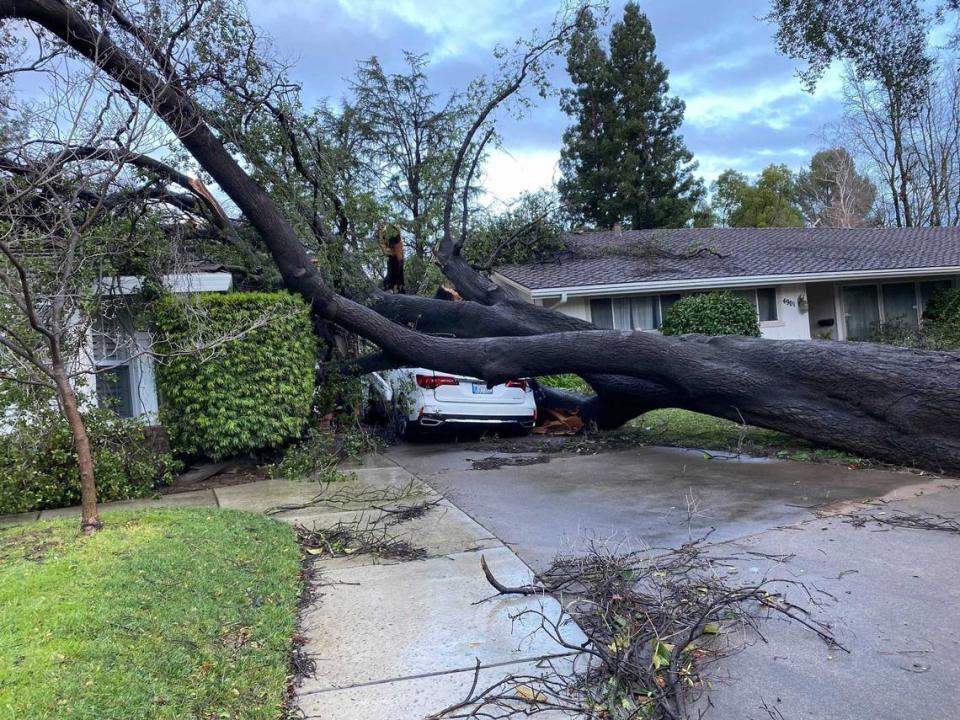
Trees come down in Carmichael: ‘It was crazy’
Charles Crowder, a resident of the Del Dayo Estates neighborhood in Carmichael, was taking photographs of the carnage early Monday at Marlborough and Sherlock ways. “Nobody can do anything with this,“ he said. “Look at this. This is incredible.”
Crowder said he has the largest tree in the neighborhood, but it survived the storm while others in the area near Jesuit High School and Rio Americano High School were split in half or badly damaged.
When the tree at Marlborough and Sherlock was uprooted, Crowder said, it pulled up electrical lines as well as a large sewage pipe that was broken into pieces.
Down the street at Morley and Merritt ways, Brion Maciel was assessing the damage after a cluster of massive redwoods came down in his neighborhood. One, measuring 48 inches in diameter, had snapped about halfway up the tree and slammed to the ground right outside his front door.
Maciel has lived in the house for 20 years, and said he and his wife had just come home minutes before the tree, one of five redwoods in his front yard, snapped.
“We had just taken a walk,“ he said. “We came back, headed into the house, and all of a sudden we heard a very loud pop.“
Maciel said his son thought the noise was coming from the hot tub out back, but found another tree there had fallen onto their power lines. “Then I came out here, and I was like, holy crap, it split in half.”
Maciel said he felt fortunate the wind had snapped the redwood off toward the street rather than onto his home. “We are very lucky,” he said.
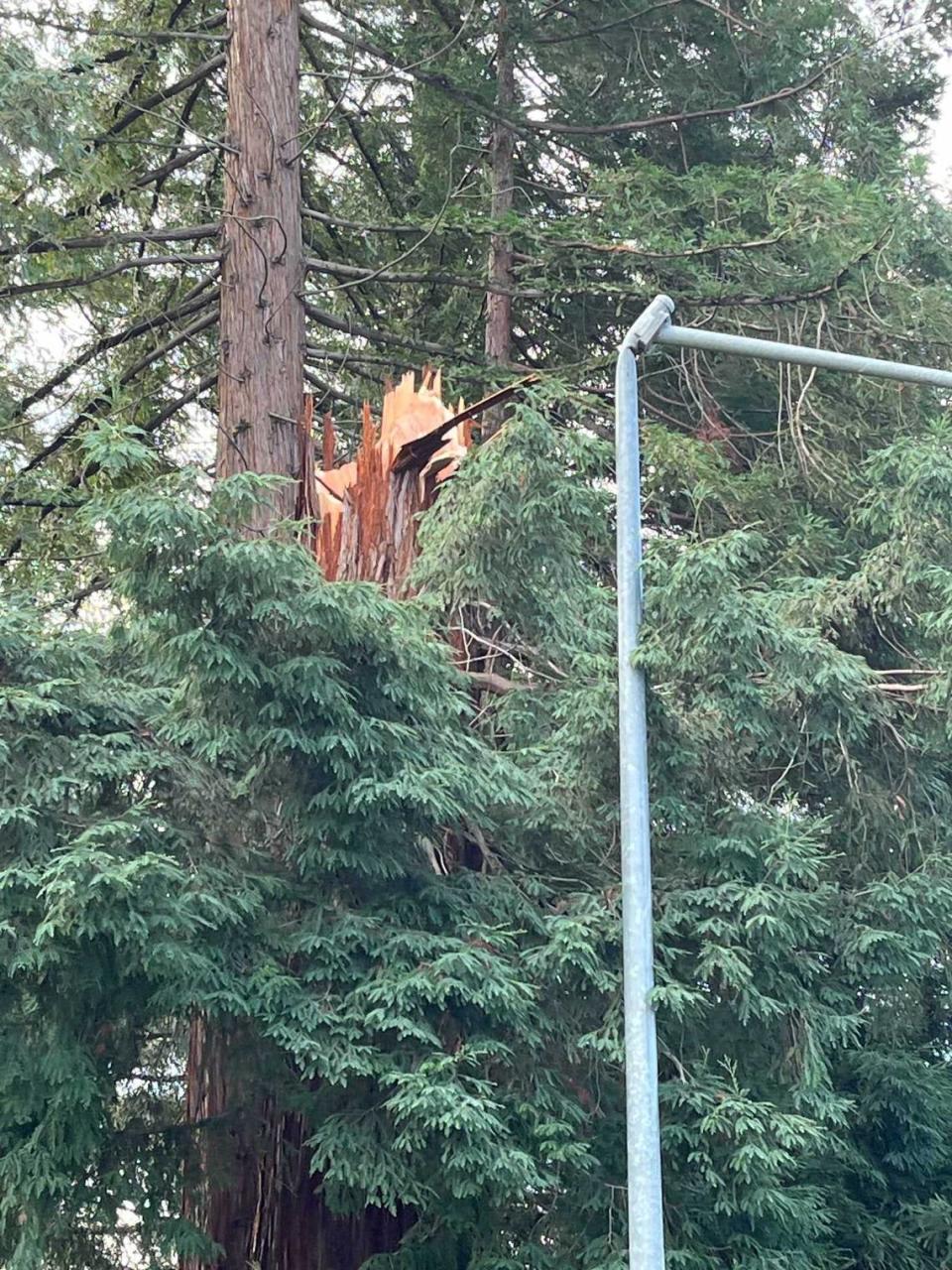
Al Harrison, a certified arborist assessing the tree damage, estimated the snapped portion was 75 feet long and weighed more than 7,000 pounds. Harrison said the most likely cause was the installation of a concrete driveway next to the tree at the start of the COVID-19 pandemic. The driveway, he said, likely cut off roots and limited the tree’s ability to pull in enough water.
When the section of the tree smashed into the street, it shattered into pieces, which Harrison said was a sign that the tree had not been getting enough water.
Harrison said the lack of water made the tree less flexible and unable to sway with the heavy wind.
“When the roots get cut like that, it compromises the structural stability in a big way,” Harrison said.
‘I think it was time for it to go’
The grand sycamore tree in front of Simone and Mark Rathe’s home in Curtis Park was already huge when they moved into their home on Third Avenue 35 years ago. The tree had withstood decades of winter storms.
But around 4 p.m. Sunday, it was clear the tree was going to fall. The sidewalk above its roots lifted as the wind howled. Frantic neighbors moved their cars and, at about 7:30 pm, the tree toppled into the street. Nothing was damaged and no one was injured.
“It came down so gently,” Simone Rathe said Monday as she gathered small branches strewn about her block. “I think it was time for it to go. I think it had lived its life.”
Video shows moment tree falls in Sacramento storm, tearing up sidewalk
Sacramento’s older, tree-lined neighborhoods seemed largely sparred of significant damage from the weekend storm. A couple of trees were down inside William Land Park. But for the most part, only small branches and twigs lined the streets.
The city of Sacramento saw 400 reports requiring tree service to its 311 hot line, said Gabby Miller, a spokeswoman with the city. She added multiple people could be calling about a single problem requiring tree service.
Crews patrolled Sunday night to clear roads from debris, but were prioritizing two calls for trees crashing roofs Monday morning near Southside Park and Land Park, she said. Both reports came in Sunday night, Miller said.
“It’s kind of been nonstop,” Miller said of the storm damage.
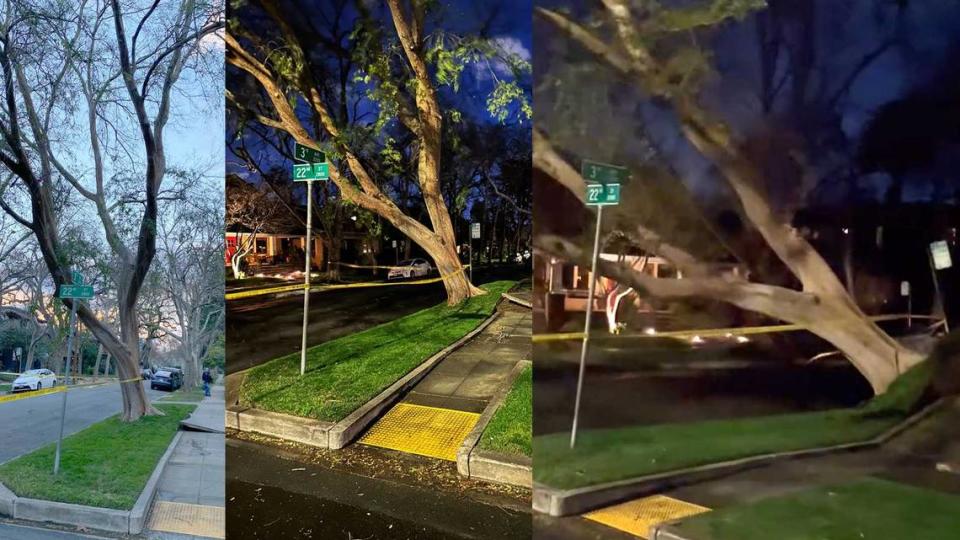
Parks closed, waterways filling up
All Sacramento County parks remain closed Monday as crews assessed and cleared debris, according Ken Casparis, a spokesman with Sacramento County. He said the county had originally planned to only close Discovery Park but expanded the closures as high winds wreaked havoc on the public green spaces.
“It was crazy yesterday,” Casparis said.
Casparis said the closure at Discovery Park was tied to rising levels in the Sacramento and American rivers, specifically around the confluence. The Sacramento River at I Street was expected to reach 21 feet on Monday afternoon, 6 feet below the monitoring stage — but still high enough to warrant closure because of flooding in the park, he said.
While crews were still working to inspect the parks, Casparis said a restroom at River Bend Park was damaged after a tree fell onto it.
Area creeks were also beginning to fill up. Sacramento County officials said just before 9 a.m. that Arcade Creek near American River College had reached monitoring stage after rising to 74.81 feet. Flood stage for that portion of the waterway is 76.34 feet.
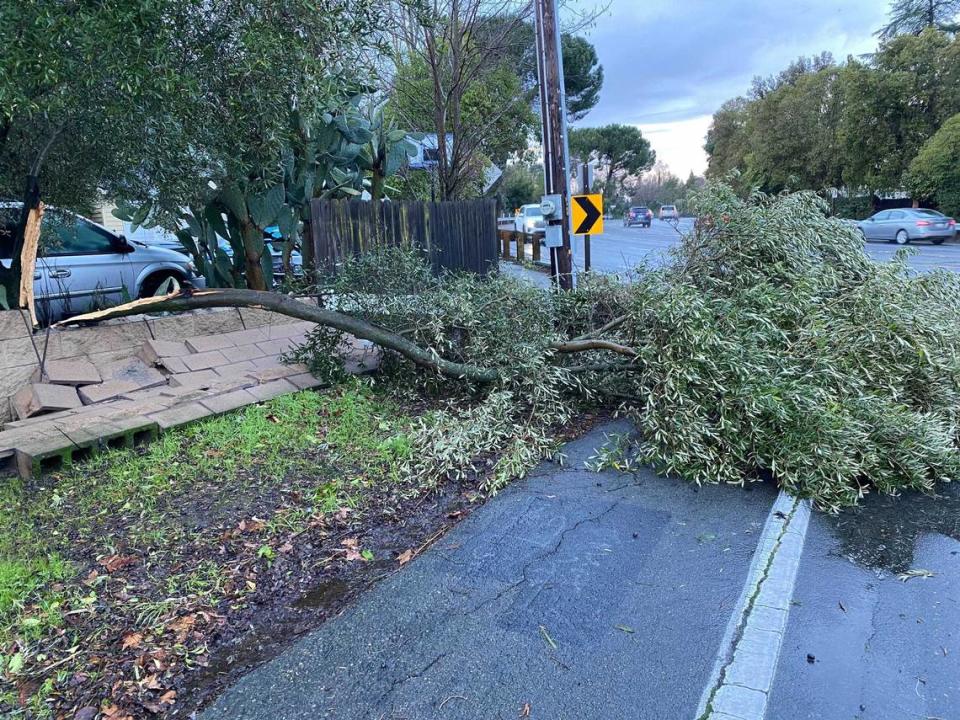
Sacramento schools affected by outages
Schools were also grappling with scattered outages Monday morning.
San Juan Unified School District officials said just after 7 a.m. that its schools in the eastern suburbs were planning to open as normal, though 10 campuses remained without electricity. Those schools were: Albert Schweitzer Elementary, Arlington Heights Elementary, Carmichael Elementary, Coyle Avenue Elementary, Del Paso Manor Elementary, Deterding Elementary, El Camino Fundamental High, Green Oaks Elementary, Mariemont Elementary and Oakview Community Elementary.
“All of our schools will open Monday as scheduled, but if power is not restored by 11 a.m., we will have a minimum day schedule for students,” officials said in an update to parents. “If you do not feel comfortable with your children attending school, we understand. However, we will continue to provide a safe space for students with meals and continued instruction.”
The Sacramento City Unified School District closed two high school campuses after power was knocked out. Students at West Campus and Sacramento New Technology high schools are expected to return Tuesday, said Al Goldberg, a spokesman for SCUSD.
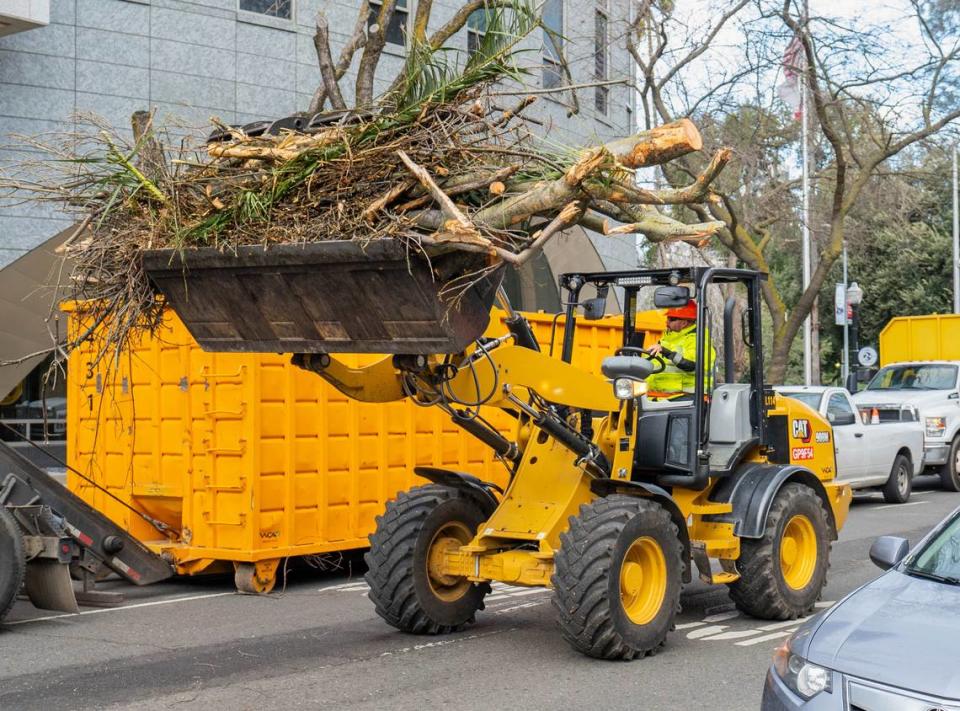
Twin Rivers Unified School District also had five schools without power — Del Paso Elementary, Foothill High, Foothill Ranch Middle, Ridgepoint and Woodridge — and would follow similar procedures.
Only one school remained without power in the Folsom Cordova Unified School District. Officials said school administrators would keep parents and staff updated on the status of Theodore Judah Elementary.
In Placer County, Rocklin Unified district officials canceled school at four campuses: Antelope Creek Elementary, Sierra Elementary, Rocklin Elementary and Spring View Middle. In Nevada County, all schools were closed Monday in the Grass Valley School District.
Sierra College in Rocklin and Yuba College in Marysville canceled all classes Monday, officials said, as foothill communities grappled with debris cleanup, outages and snow. Schools in the Tahoe-Truckee Unified district were closed for a snow day but Lake Tahoe Unified School District campuses remained open.
The Marysville Joint Unified School District also shut down classes Monday across its 20 campuses.
Street crews cleaning up roadway debris
Traffic was moving mostly without incident on Sacramento area freeways, according to CHP and Caltrans officials, as maintenance crews took to surface streets to clear debris that had fallen overnight.
Branches and other debris had blocked several streets in downtown, midtown and East Sacramento, giving city crews plenty to address. Roads in the eastern suburbs of the county, as well as the foothills, were also affected as county maintenance teams worked through the early morning to get roadways back in shape.
Most of the roadway flooding was confined to rural areas in Yolo County, though officials said at about 7 a.m. that the ramps on Interstate 80 at the Penryn exits had been “underwater,” according to the California Highway Patrol. Interstate 505 in western Yolo County had been briefly shut down due to flooding.
Other debris made the Monday commute difficult, authorities said, including a trampoline that was “about to fly into lanes” on eastbound Highway 50 at Mather Field Road. Branches, light poles, power lines and traffic signals were down complicating travel at Newhall and Applegate drives in Rosemont, Elkhorn and Rio Linda boulevards in Rio Linda, and along Roseville Road at Longview Drive in North Highlands.
‘This is getting to be a normal thing’
Crews worked 24 hours to plow snow in the Sierras and clear trees in Placer County throughout the weekend, said Donny Francis, a roads manager for the Department of Public Works in Placer County.
“This is getting to be a normal thing for these bigger storms,” Francis said of the county’s response.
Trees struck power lines, which cannot be touched until a utility worker can give the OK, Francis added. An electrical current can pass through debris touching the electrical wire, which can shock residents.
But the storm’s total effect on the region was still being assessed — rain was expected to continue in places like Auburn, which could cause some more flooding as water makes its way to the valley floor, he said.
Sacramento County’s 311 line — used by residents to inform county officials of downed trees blocking roads — has received 135 calls for reports of downed trees, 55 calls for signal issues and 15 calls to for road blockages as of Monday morning, said Matt Robinson, a county spokesman.
The North Highlands area experienced flooding while downed power lines in unincorporated Sacramento County caused complete road closures, he said.
“Crews are trying to get out there as fast they can to get this taken care of,” Robinson said.
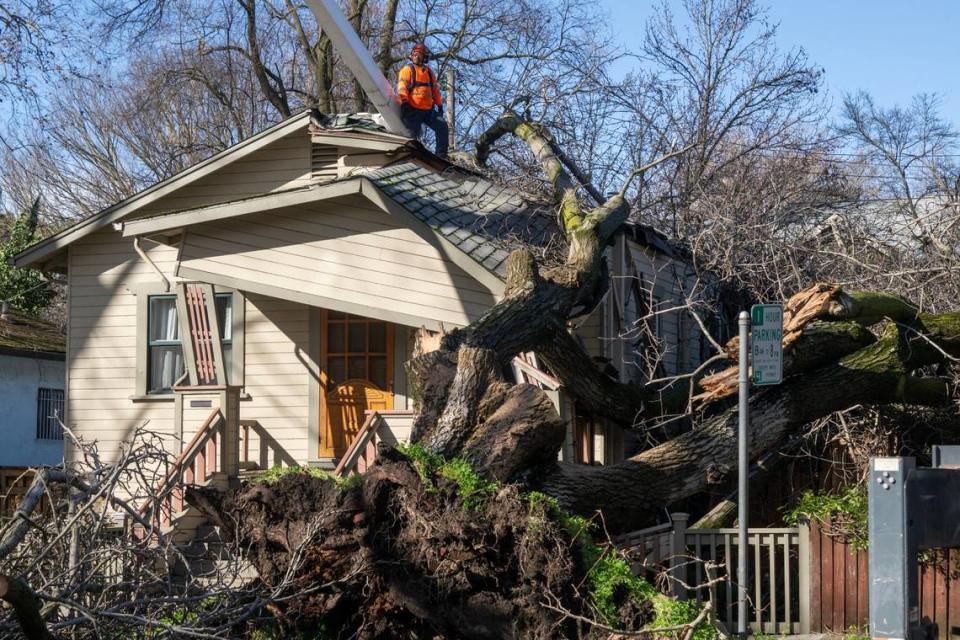
Rain totals vary across region
In the past 24 hours, Sacramento County experienced anywhere from 0.25 inches to 1.5 inches of rain, Rick said.
Rancho Cordova saw about 1.5 inches of precipitation, some of the heaviest in Sacramento County, the meteorologist added.
The rainfall totals were running about average for this time of year, he said. Averages from Jan. 1 until Monday are 3.78 inches when accounting for previous years. However, this year, there’s been 5.28 inches of rain in the same period, Rick said.
Yolo County also similarly saw precipitation stay within the average — the Yolo County airport saw 2.41 inches of rain. The unincorporated area of Brookes saw 3.71 inches of rain, Rick said.
The hardest hit areas included Grass Valley: It experienced 3.5 inches of rain over 24 hours ending at 7 a.m., with a majority of the precipitation falling overnight, Rick said.
Southern parts of Placer saw about 0.34 inches of rain, Rick said.
The foothills in the Sierras saw about 1.5 to 2.5 inches of rain, he added, noting El Dorado County saw a minimum of 0.5 inches of rain over 24 hours.
There’s a chance for scattered thunderstorms throughout the capital region as the next storm system comes from the Bay Area and Monterey, Rick said.
By late evening, the chances for rain will leave the area. El Dorado County could see showers Tuesday as the storm moves east, he said.
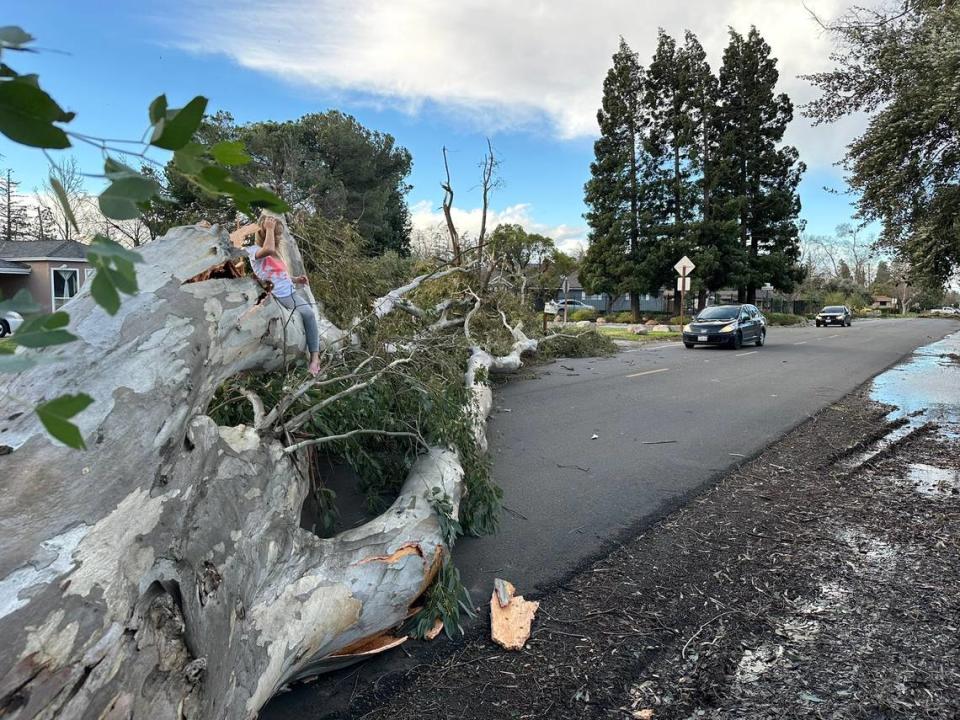
Storm stalling over Southern California
The slow-moving storm Monday moved on to Southern California, where officials warned of potentially devastating flooding and ordered evacuations for canyons that burned in recent wildfires that are at high risk for mud and debris flows.
Multiple homes were damaged and at least one water rescue was underway as a large and dangerous storm system continued its push through the region where at least 1.4 million people were under a flash flood warning.
Much of the state had been drying out from the atmospheric river that blew in last week, causing flooding and dumping welcome snow in mountains. The latest storm, also called a “Pineapple Express” because its plume of moisture stretches back across the Pacific to near Hawaii, arrived offshore in Northern California on Saturday, when most of the state was under some sort of wind, surf or flood watch.
Gov. Gavin Newsom declared a state of emergency for Los Angeles, Orange, Riverside, San Bernardino, San Diego, San Luis Obispo, Santa Barbara and Ventura counties where evacuations were ordered. The Governor’s Office of Emergency Services activated its operations center and positioned personnel, roughly 8,300 people, and equipment in areas most at risk.
Rainfall totals were continuing to pile up by lunchtime, including 10.28 inches in the Topanga area and 5.3 inches in downtown Los Angeles — with much more on the way, according to Ryan Kittell, a meteorologist with the National Weather Service in Oxnard.
“There’s still a lot of rain to come,” he said. “There’s a lot of rain left.”
The Associated Press, the Los Angeles Times and The Bee’s Brianna Taylor, Hahn Truong , Jacqueline Pinedo and Ryan Lillis contributed to this story.

